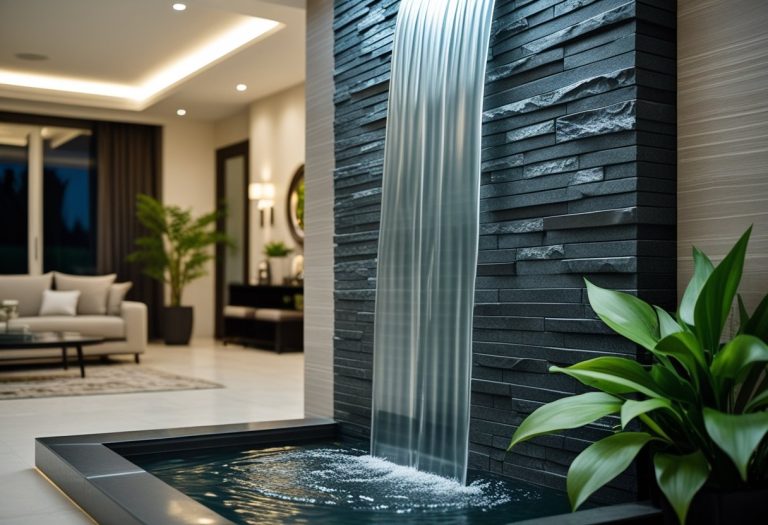Modern Neutral Home Decor : Cozy Minimalism & Japandi
Modern neutral home decor offers a seamless blend of simplicity and warmth, making it an ideal choice for those seeking a calm, clutter-free environment. Combining cozy minimalist interiors with warm wood tones, earthy textures, and natural light creates spaces that feel both inviting and serene. This style draws inspiration from Scandinavian simplicity and Japandi elegance, emphasizing functionality without sacrificing comfort.

The key to transforming a home with this trend lies in balancing clean lines with natural, tactile materials to foster an atmosphere of calm and coziness. Whether refreshing a bedroom or reimagining a living room, the focus is on creating spaces that encourage slow living and organic modern aesthetics. Neutral tones and thoughtful design choices provide a timeless backdrop for every corner of the home.
The Essence of Modern Neutral Home Decor
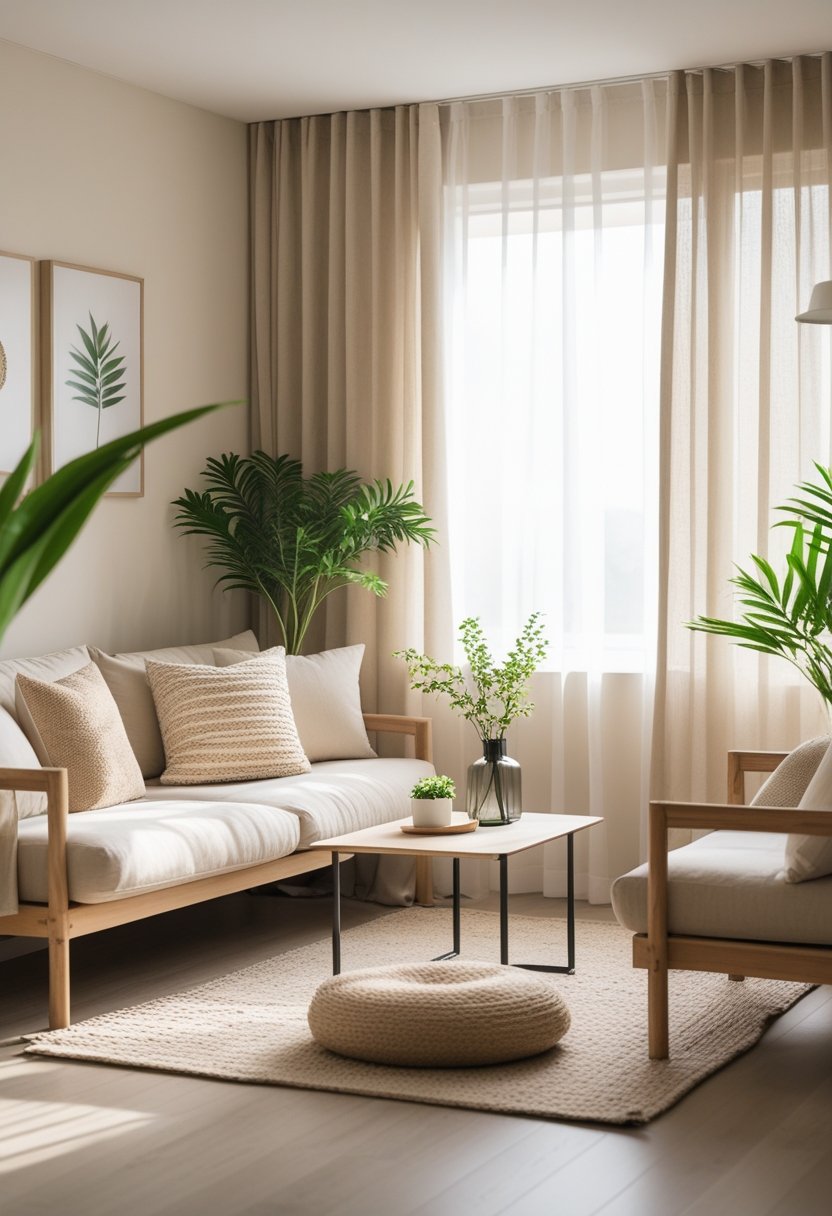
Modern neutral home decor centers on a balance of simplicity, warmth, and natural elements. It emphasizes clean lines, muted colors, and a thoughtfully curated environment that fosters calm and clarity.
Defining the Neutral Aesthetic
The neutral aesthetic relies on a palette of soft, muted tones such as beige, cream, gray, and taupe. These colors serve as a versatile foundation that adapts easily to various styles without overpowering the space.
Neutral tones in interior design create a subtle backdrop that highlights textures and shapes rather than bold colors. This approach draws attention to materials like linen, wool, and wood. The result is an environment that feels open, serene, and timeless.
In minimalist decor, the neutral aesthetic supports clutter-free spaces by emphasizing quality over quantity. This enhances the sense of order and spaciousness in modern interiors.
Scandinavian and Japandi Influences
Scandinavian design is known for its functionality, simplicity, and connection to nature. It uses light woods, natural fibers, and a neutral palette to maximize light and air. This creates interiors that feel bright, clean, and inviting.
Japandi blends Scandinavian minimalism with Japanese craftsmanship and wabi-sabi philosophy. It introduces darker wood tones, rustic textures, and handcrafted accents alongside the Scandinavian foundation. This creates balance through contrast and celebrates imperfect beauty.
Both styles prioritize natural light, uncluttered spaces, and a restrained use of decor. Together, they form a cohesive language of calmness, organic materials, and understated elegance that defines modern neutral interiors.
Minimalism Meets Warmth
Minimalist decor often risks feeling cold or sterile. Modern neutral home design avoids this by layering warm wood tones and earthy textures to soften the space.
Incorporating elements like woven baskets, textured throws, and natural jute rugs adds depth and tactile interest without disrupting the clean aesthetic. Warm woods, such as oak or walnut, replace harsh synthetic finishes and introduce an inviting glow.
This approach maintains minimalist principles of simplicity and function while creating a cozy, lived-in atmosphere. It supports slow living by encouraging intentional choices and appreciation for natural materials within a calm, clutter-free setting.
Building Your Neutral Color Palette
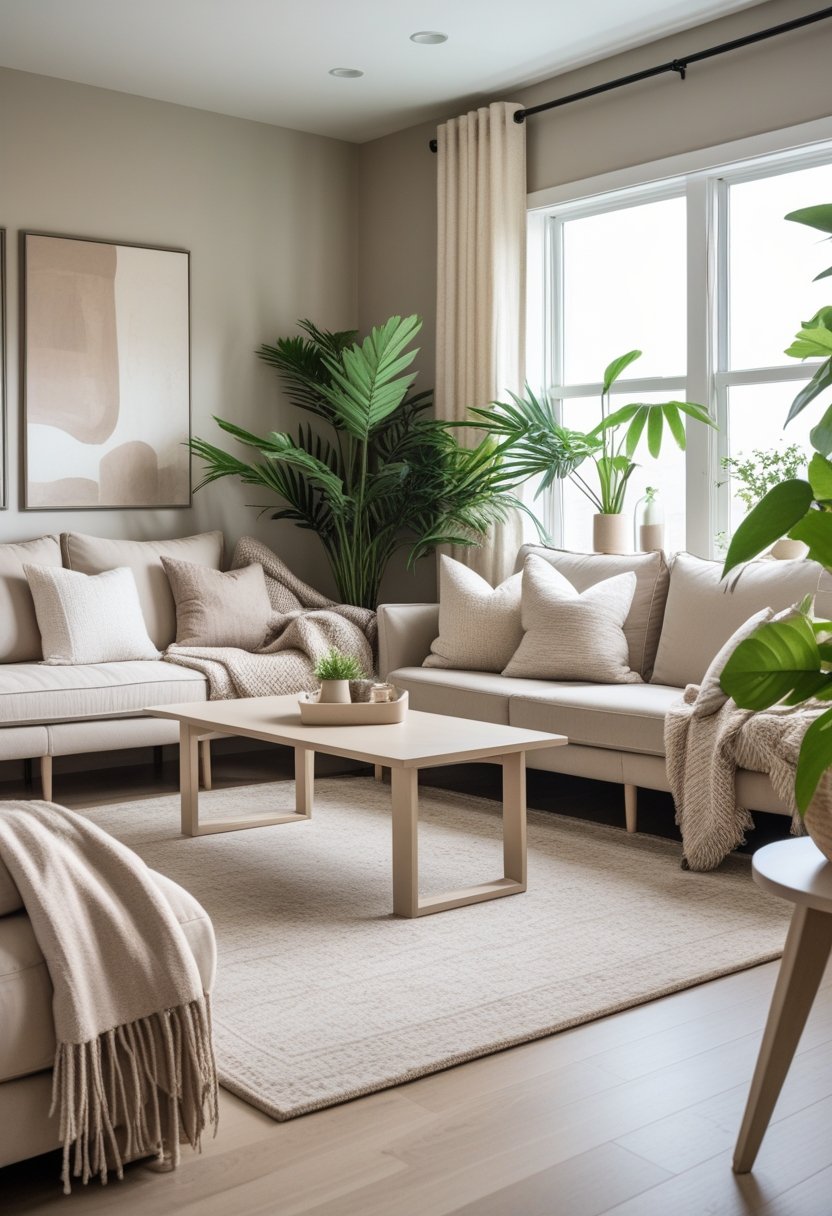
Creating a balanced neutral palette involves careful selection of colors that complement each other without overpowering the space. Emphasizing the right mix of soft whites, muted tones, and natural shades brings warmth and sophistication while maintaining a clean, airy feel.
Choosing the Right Neutral Colors
Selecting neutral colors goes beyond simple beige or gray. It involves identifying colors with subtle variations such as warm taupes, cool greys, and earthy browns. These shades create dimension and depth more effectively than flat neutrals.
When choosing colors, consider the room’s natural light and the atmosphere you want. For example, warmer neutrals like soft browns and creams work well in cozy spaces, while cooler tones like greys and muted blues suit more modern, minimalist environments.
Heavier or darker neutrals add weight and contrast, grounding the room. Lighter neutrals create openness and softness, ideal for smaller or naturally darker rooms.
Harmonizing Undertones and Muted Shades
Undertones are key to achieving harmony within a neutral palette. Matching warm undertones such as yellow, peach, or red with similarly warm muted shades avoids clashing colors that disrupt the flow.
For example, pairing a warm beige with creamy off-whites and soft wood tones creates a consistent, inviting aesthetic. Conversely, pairing cool greys with crisp whites and muted steel blues produces a more contemporary, calming environment.
Muted shades are preferable to saturated colors. They add subtle color without breaking the neutral scheme, allowing mixing of textures and materials to become the focus.
Using White and Cream for Balance
White and cream shades act as essential anchors in a neutral palette by providing clarity and brightness. Crisp whites highlight architectural details or create contrast against warmer, muted tones.
Cream tones soften the contrast found in white, offering a warmer, deeper base that reflects natural light gently. Both are versatile and can suit any room or style, from minimalist to cozy.
Strategically placing white or cream on walls, ceilings, or trim enhances the sense of space and cleanliness. They also balance darker neutrals and prevent the room from feeling too heavy or dull.
Highlighting with Gold and Brass Accents
Adding gold or brass accents introduces warmth and subtle luxury to a neutral interior. These metallic tones complement earthy neutrals and soft whites without overwhelming the palette.
Common applications include lighting fixtures, hardware, mirrors, and decorative objects. Gold and brass bring an organic glow that enhances texture and layers within the space.
The key is restraint—using these accents sparingly creates focal points and elevates the overall design without cluttering. This approach aligns well with modern neutral trends that favor understated elegance.
Layering Textures and Materials

Layering textures and materials creates visual interest and depth without cluttering the space. Combining tactile natural elements and subtle patterns enhances the warmth and calm of a modern neutral interior.
Incorporating Natural Wood and Raw Finishes
Natural wood is foundational to creating warmth in minimalist decor. Using raw or lightly finished wood surfaces preserves organic grain and texture, which adds character without overwhelming simplicity.
He or she can choose furniture made from oak, ash, or walnut with matte or unfinished surfaces to maintain a natural feel. Exposed wooden beams, raw wood shelving, or accent tables work well to introduce this element. The contrast between smooth walls and rough textures of wood creates balance while keeping the space grounded and tactile.
Integrating raw finishes means avoiding glossy or synthetic treatments. Instead, embracing natural imperfections and wood’s varying tones enhances authenticity, tying together both Scandinavian and Japandi influences.
Blending Linen and Luxurious Fabrics
Linen is central to layering fabrics in a neutral space because of its natural texture and understated elegance. It provides softness without drawing too much attention, making it ideal for curtains, cushion covers, or throws.
Combining linen with smoother or more refined fabrics like velvet or silk creates a tactile dialogue that elevates the room’s coziness. For example, pairing a linen sofa with velvet cushions introduces luxury while maintaining organic appeal.
This approach balances casual comfort with sophistication. Choosing muted earth tones or whites for linens ensures harmony with natural wood elements, fostering a cohesive and relaxing atmosphere.
Adding Depth with Organic and Geometric Patterns
Organic and geometric patterns bring subtle visual texture and dimension without compromising minimalism. Organic motifs like leaf or wave shapes echo nature and complement raw wood and linen textures.
Geometric patterns add structure and rhythm. Simple designs such as stripes, grids, or angular shapes in rugs, throws, or wallpapers contribute contrast and highlight clean lines found in modern furniture.
Both pattern types should be used sparingly to avoid visual clutter. When mixed thoughtfully, they provide a layered effect that enhances spatial interest, enriching the sensory experience while maintaining calm and order.
Curating Furniture and Statement Pieces
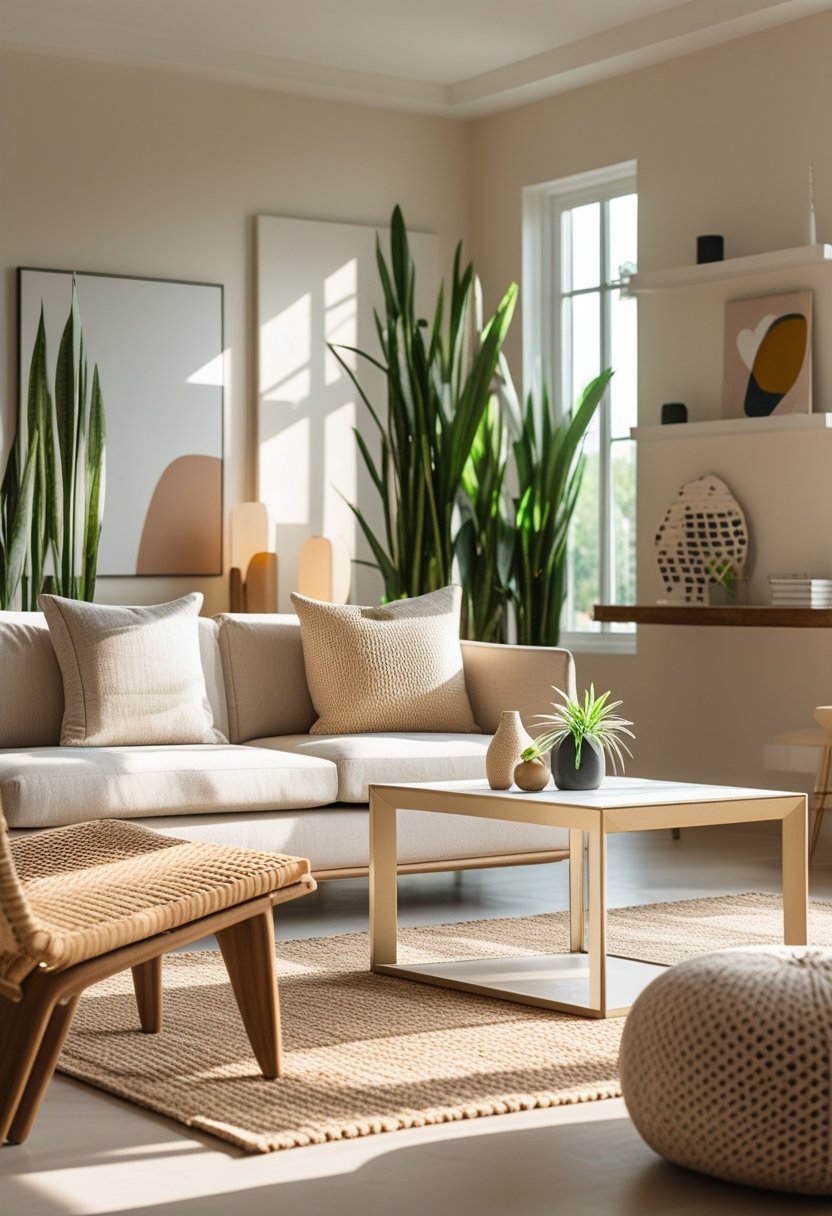
A thoughtful selection of furniture and statement items shapes the balance between function and style. Clean lines, natural materials, and purposeful storage define this approach. The right combination highlights simplicity without sacrificing warmth or personality.
Selecting White and Light Wood Furniture
White furniture paired with light wood tones forms a foundational element of modern neutral interiors. Pieces in matte or satin finishes with minimal hardware emphasize Scandinavian-inspired austerity. This duo brightens spaces and provides a versatile backdrop for seasonal accents or textured textiles.
Furniture such as dressers, tables, and beds crafted from light oak or birch create subtle contrast. This mix supports an airy, uncluttered look while avoiding sterility. Durability and craftsmanship matter, so choosing pieces with solid construction ensures longevity without interrupting visual calm.
Warm Wood Tones in Modern Settings
Incorporating warm wood tones introduces depth and tactile richness to neutral designs. Walnut, teak, and cherry add visual interest and organic warmth that counterbalance cool whites and grays. These woods often appear as accent furniture or statement pieces like coffee tables, shelving units, or accent chairs.
The key lies in placement and proportion. A single warm wood element can anchor a room, preventing the neutral palette from feeling flat. Combining soft upholstery with smooth wood textures enhances comfort without clutter or distraction. Finish choices that maintain wood’s natural grain are preferred for authenticity.
Using Woven Baskets and Storage Solutions
Woven baskets serve dual roles as decorative accents and practical storage. Materials like rattan and seagrass complement the earthy tone of warm woods and add texture to minimal spaces. They are ideal for organizing blankets, magazines, or everyday items while maintaining a curated appearance.
Sizes and shapes vary based on function, from small tabletop baskets to large floor containers. Grouping different basket styles can create layered interest without visual noise. Choosing baskets with sturdy construction and neutral hues integrates them seamlessly into both bedrooms and living rooms.
Strategic Lighting and Serene Atmosphere
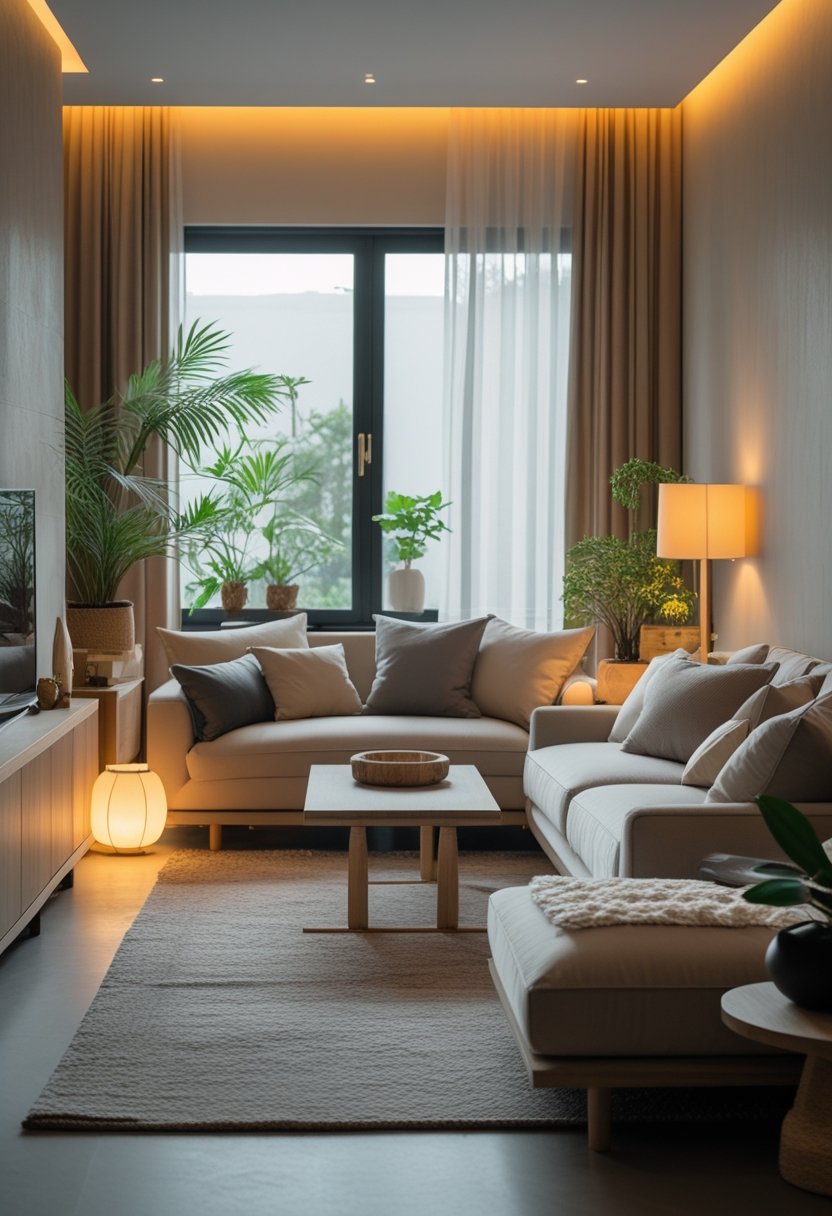
Creating a calm and inviting atmosphere depends heavily on thoughtful lighting choices that balance natural and artificial sources. Using natural light effectively, selecting the right table lamps and fixtures, and incorporating sheer curtains all contribute to a cohesive and tranquil space.
Maximizing Natural Light and Airiness
Natural light enhances the open, airy feel essential to modern neutral interiors. Large windows or glass doors should remain unobstructed to allow maximum sunlight during the day. Positioning mirrors opposite windows can reflect light deeper into the room, increasing brightness without additional fixtures.
Avoid heavy window treatments that block daylight. Instead, opt for minimal window frames and keep furniture low to prevent interference with light flow. This approach connects the interior with the outdoors, reinforcing the serene mood by emphasizing openness and airiness.
Choosing Table Lamps and Lighting Fixtures
Table lamps serve both functional and decorative purposes, adding warmth and layered illumination. Select lamps with neutral shades—linen or light-toned fabrics work well to diffuse light softly, preventing harsh glare. Bases in natural materials like wood or ceramic complement the warm, earthy palette.
Incorporate lighting fixtures with simple designs and clean lines to maintain the minimalist aesthetic. Warm white bulbs (2700K–3000K) are preferable to cooler tones, as they produce a cozy and inviting glow. Use dimmers to control light levels, adapting the room’s ambiance from bright to mellow as needed.
Embracing Sheer and Lightweight Curtains
Sheer curtains soften incoming light without completely blocking it, preserving brightness while reducing glare. Fabrics like linen or light cotton provide texture that adds visual interest without overpowering the space. Their translucency allows natural light to filter evenly, maintaining the neutral palette’s calm effect.
Lightweight curtains also add movement to the room, lending a subtle dynamic without clutter or heaviness. They frame windows delicately and provide privacy during the day. Choosing neutral tones such as whites, creams, or soft grays ensures harmony with the overall design scheme.
Accessories and Natural Elements

Accessories combine texture and simplicity to enhance the neutral palette without overpowering it. Natural elements introduce a calm, grounded feeling while remaining functional and stylish in a modern minimalist home.
Styling with Ceramic Vases and Artful Details
Ceramic vases are ideal for adding subtle sculptural interest to a space. Their organic shapes and matte finishes complement earthy tones, creating warmth without disrupting the neutral color scheme.
Choose vases in beige, soft gray, or muted terracotta to enhance the natural vibe. They work well on shelves, side tables, or as centerpieces with dried grasses or simple stems.
Artful details like handcrafted bowls or textured trays add layered depth and encourage tactile engagement. These accessories maintain simplicity but invite attention to material quality and form, fitting perfectly in a cozy minimalist space.
Incorporating Plants: Snake Plant and Pothos
The snake plant and pothos are both low-maintenance, ideal for adding greenery to neutral spaces without complexity. Snake plants bring vertical structure with their sharp, upright leaves. Their deep green contrasts softly against light neutral walls or wood tones.
Pothos offers trailing greenery with heart-shaped leaves, ideal for shelves or hanging planters. Both plants improve air quality and introduce a fresh, natural element, grounding the room in organic modern style.
Placing these plants near natural light sources enhances their health and the room’s atmosphere. Their unobtrusive presence keeps the space feeling airy and clutter-free.
Personal Touches with Art and Decor
Personalized art and unique decor anchor the minimalist look with individual character. Opt for framed prints or abstract paintings in neutral palettes to avoid visual chaos.
Sculptural objects or handmade textiles add subtle personality while staying true to natural materials and muted colors. These elements should feel intentional, enhancing the softness and calmness already established by the neutral foundation.
Curating a few well-chosen pieces instead of many maintains the uncluttered essence of the design, reinforcing a serene and balanced living space.
Modern Neutral Bedrooms and Living Spaces
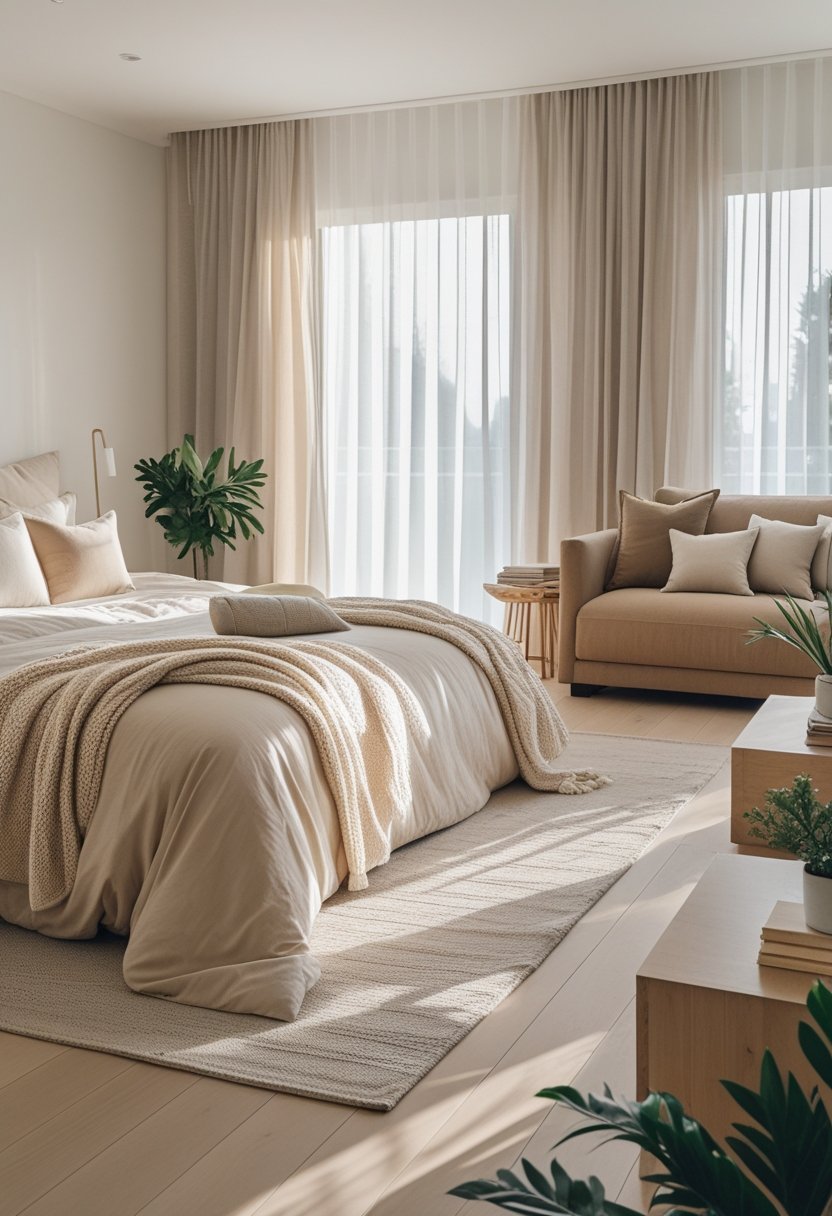
Modern neutral interiors focus on simplicity, natural materials, and soft tones to create spaces that feel both inviting and calm. Warm wood, muted colors, and thoughtful design choices foster a balanced atmosphere in bedrooms and living areas, enhancing comfort without clutter.
Calm, Clutter-Free Bedroom Retreats
Neutral bedrooms prioritize tranquility through minimal decor and a restrained color palette. Shades like beige, taupe, and soft gray establish a peaceful backdrop. To avoid coldness, subtle textures—such as linen bedding or woven rugs—add warmth and tactile interest.
Essential furniture pieces are streamlined and functional, often crafted from natural wood or matte finishes to enhance warmth. Lighting choices emphasize softness, using lamps or diffused natural light to maintain a restful atmosphere. Storage is integrated discreetly, keeping surfaces clear to promote mental calm.
Plants or simple organic accents can soften the space while maintaining the serene aesthetic. The goal is a bedroom that encourages relaxation by balancing clean lines with cozy elements.
Designing Airy, Open Living Rooms
Living rooms in a modern neutral home embrace openness and natural light. Furniture is selected for both comfort and simplicity, favoring low-profile designs in neutral tones that blend seamlessly with wooden accents.
Layering textures like wool throws, jute rugs, and linen curtains enriches the space without overwhelming it. Layouts focus on clear pathways and uncluttered surfaces to enhance flow. Light-colored walls and large windows amplify brightness, making rooms feel spacious and airy.
Decor remains minimal yet purposeful—selective use of functional art, sculptural lighting, or subtle greenery adds character without disrupting the calm. This approach creates a welcoming environment that feels effortless and connected.
Creating Cohesion Across Spaces
Maintaining consistency between bedrooms and living rooms is key to a cohesive modern neutral home. A unified palette of soft whites, beiges, and earthy tones ties spaces together visually.
Materials such as natural wood, stone accents, and textured fabrics are repeated to form a flow that feels intentional. Furniture styles are complementary rather than matching, balancing simplicity with subtle variation.
Subtle shifts in tone or pattern mark transitions between areas while preserving harmony. Cohesion is reinforced through shared elements like organic shapes, minimal decor, and warm lighting. This fosters a seamless experience throughout the home, enhancing comfort and style.

Ana Luisa
Explore in-depth biographies, net worth insights, and exclusive updates on your favorite singers at Trionua.com. Discover the journeys, achievements, and latest news about music’s biggest stars.



